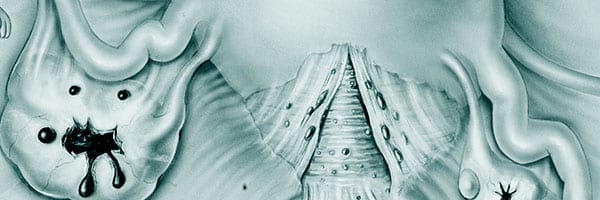Endometriosis does not discriminate against age, ethnicity or socioeconomic status. It can affect women from every walk of life and in every life-phase.
Endometriosis is a gynecological condition where tissue that is somewhat similar to the lining of the womb (the endometrium) is found outside the womb where it does not belong. This aberrant tissue contains endometrial glands and stroma. The glands secrete substances that irritate the surrounding tissues, sometimes causing them to bleed. The immune system responds to the release of these substances by releasing inflammatory proteins that rush to the site of disease, causing swelling and inflammation. The disease itself and the inflammatory response to the disease can cause the patient severe pelvic pain and, over time, scar tissue may form and bands of scarring may develop, sticking the pelvic organs together (adhesions).
Many patients will find that their symptoms fluctuate during their monthly cycle, with a worsening of pain at the time of menstruation and sometimes also during ovulation. These fluctuations are believed to be due to changes in hormone levels and their effect on the activity of the endometriosis. Endometriosis contains estrogen and progesterone receptors. These receptors modulate disease activity by responding to the levels of estrogen and progesterone in the surrounding environment. The most common site of endometriosis is the peritoneum, a saran-like wrap that cloaks the pelvis and the pelvic structures. Most women with endometriosis have flat superficial lesions involving the peritoneum that cannot be detected via imaging (ultrasound, CT or MRI). In some cases, however, the lesions are deep and invasive and can involve the bladder, bowel, ureters, ovaries and even distant sites such as the diaphragm.
It is estimated that around 1 in 10 women are affected by endometriosis, which equates to some 176 million women worldwide.
It is estimated that around 1 in 10 women are affected by endometriosis, which equates to some 176 million women worldwide. Endometriosis does not discriminate against age, ethnicity or socioeconomic status. It can affect women from every walk of life and in every life-phase: teenage schoolgirls, mothers, women who have put off having children, and women post-menopause. The disease can impact all aspects of a girl or woman’s quality of life. Many women suffer for years and visit multiple doctors before finally receiving a diagnosis. The diagnostic delay from the onset of symptoms to diagnosis ranges in average from 7 to 10 years.
Endometriosis may be suspected if a woman is suffering from pelvic pain, cyclical pain, painful sex, painful bowel movements, painful urination and/or gastrointestinal symptoms, such as diarrhea, constipation, nausea, gassiness, bloating and intestinal cramping pain. During the pelvic exam, the patient may report tenderness and pain and the physician may detect nodularity behind the patient’s uterus. Definitive diagnosis is only possible via surgery, where biopsies are obtained of any areas of abnormal tissue, sent to a pathologist for microscopic inspection and the presence of endometrial-like glands and stroma are confirmed.
The lesser-known facts about endometriosis:
- Did you know that endometriosis has been reported in stillborn female fetuses, prepubescent girls, men undergoing treatment for prostate cancer, and women born without a uterus?
- Did you know that endometriosis can persist into menopause?
- Did you know that in very rare cases endometriosis has been found involving the lung, brain, eye, kidney, and liver?
- Did you know that the oldest patient ever to be treated for endometriosis was in her 80s?
- Did you know that anecdotal reports of endometriosis date back to 1825 BC in the Kahun Papyrus in ancient Egypt?






This website is extremely helpful. I have collected more information from this website alone then I have from my doctor and his staff.
Dr. Cook
I have had severe unexplainable pain for 6 years.
6 years of bladder infections, miscarriages, testing! Finally had a laproscopy last April. Yes the pain was finally validated! It is infact Endo. Its been a little over a year and her I lay! In horrible pain!
I am going to schedule a visit to your office asap!
My marriage,my family and social life are All suffering.
Thank you for your very informative site and research!
I just cried while reading an article from your site! Its me! I totally get it now! That’s why I can’t go for long car rides and if I hold my bladder- pain that brings me to tears for days!
Thank you for raising the Bar! Thank you for your obvious desire of goodwill to specialize in a disease most Doctors s shy away from!
Thanks for not just punching a time clock or meeting some quota!
Thankyou-
I need to know if ovarian cysts can lead to endometriosis as I have had for 2 years and they put me on bc pill. I don’t like taking the pill and they keep saying it will regulate – but I’ve told my doctor I have pelvic pain and I know my body and something just isn’t right. The symptoms of this are what I am feeling, however, I am 48 yrs old and have had 2 natural childbirths – and my doctor has never once mentioned endo…. what kind of test will I need if cysts can lead to endo? thanks. kristine
Permalink